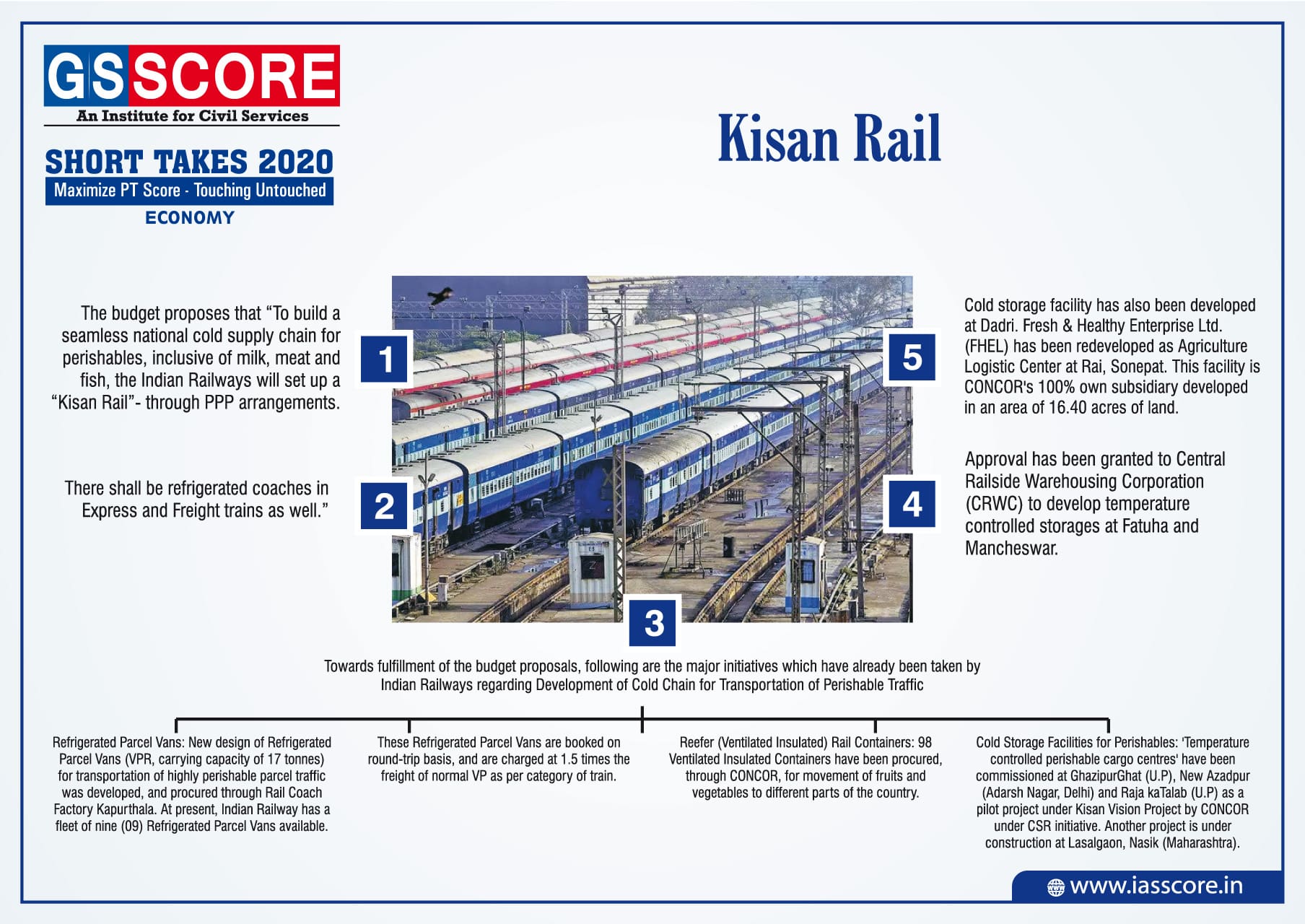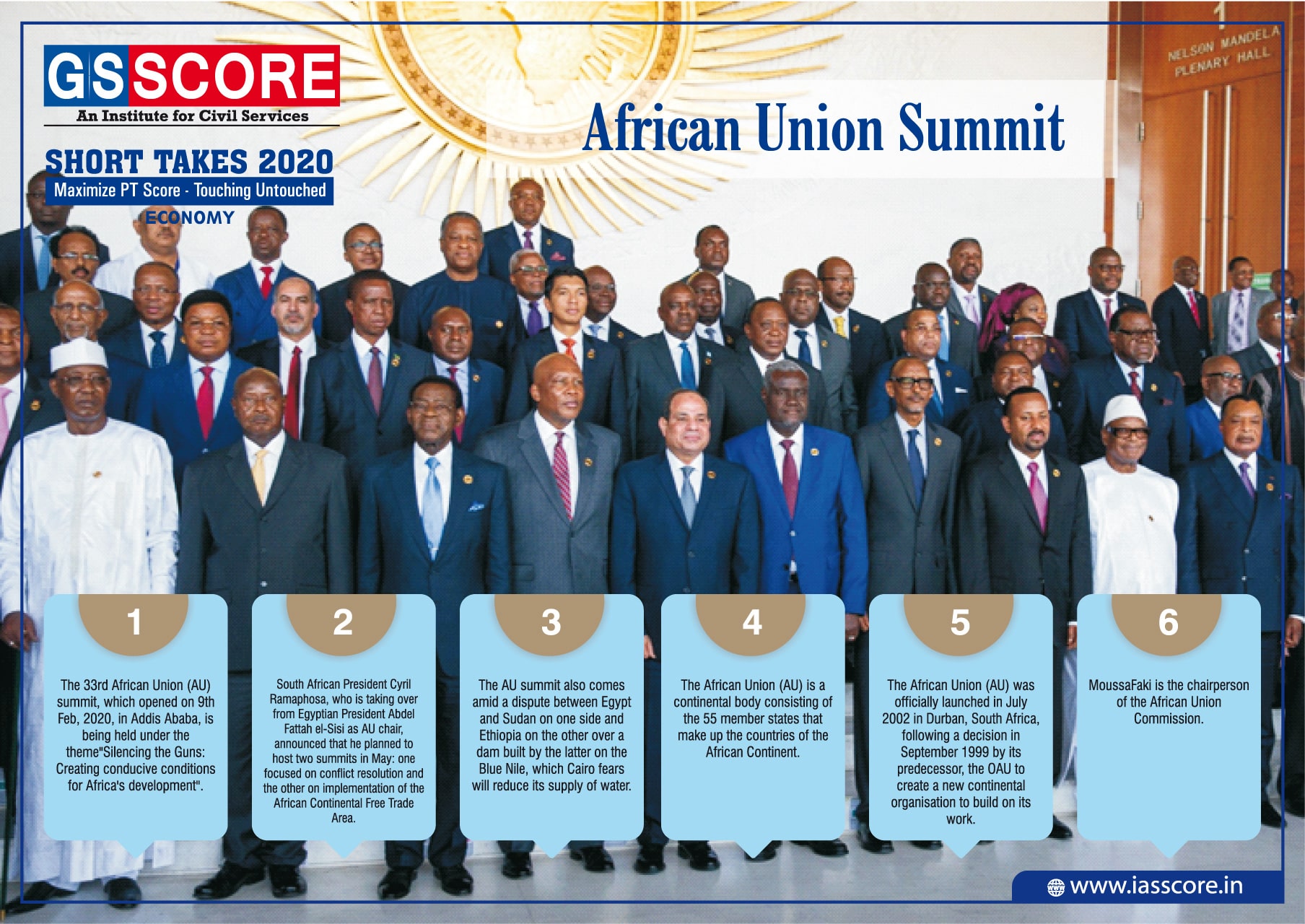Economy: Revision Test 1
Assemble in India model

Import duty on Green Energy Equipment hiked

16-point action plan to boost agriculture & farmers' welfare

Kisan Rail

African Union Summit

Asset Monetisation Programmes
Context
It Budget 2020, government proposed to use tax sops to nudge overseas investors towards its upcoming asset monetization schemes.
About
- Overseas investors for asset monetisation programmes: Government did not make major announcements for the infrastructure sector and, instead, proposed to use tax sops to push overseas investors towards its upcoming asset monetization programmes.
- Lower allocation to key infra sectors: A reading of the expenditure budget shows that the government’s total allocation to four key infrastructure segments—roads, airports, railways and civil aviation—is nearly 4% lower for FY21 than the revised budget estimates of Rs. 4,64,928 crore spent on these sectors in FY20.
- Low allocation towards capital spending: According to ICRA the budgetary allocation towards capital spending for the ministry of road transportation and highways for FY21 was around 18% lower than what was required to fund the government’s flagship Bharatmala programme.
- Even Internal and Extra Budgetary Resources (IEBR), which includes market borrowings and asset monetization, for National Highways Authority of India (NHAI)—the nodal agency that builds India’s roads— had a lower budget allocated for FY21, against in FY20.
- Focus on capital conservation: The government seems to be in capital conservation mode and is focusing on implementing existing projects already announced before than taking up any new project.
- There is thrust on asset monetization.
- There are plans to privatize more roads and one major port.
- Upcoming projects: Government will focus on development of 2,500 km of access-control highways, 9,000 km of economic corridors, 2,000 km of coastal and land port roads, and 2,000 km of strategic highways.
- The Delhi-Mumbai expressway and two other packages will be completed by 2023 and the Chennai-Bengaluru Expressway will also be started.
Asset Monetisation Programme
- The Department of Investment and Public Asset Management (DIPAM) is working on restructuring and asset monetisation of public sector enterprises for better management and competitiveness in the present world.
- Cabinet has approved procedure and mechanism for Asset Monetization of Central Public Sector Enterprises (CPSEs)/Public Sector Undertakings (PSUs)/other Government Organizations and Immovable Enemy Properties.
- Objective: The objective of the asset monetization programme of the Government of India is to unlock the value of investment made in public assets which have not yielded appropriate or potential returns so far.
- Procedure and Guidelines: Guidelines for asset monetisation programme include principles and mechanism for capital restructuring of CPSEs regarding payment of dividend, issue of bonus shares, and buyback of shares by CPSEs.
- It shall apply to all corporate bodies where government of India has controlling interest.
- The focus of these guidelines is on optimum utilization of funds by CPSEs to spur economic growth.
- Asset Monetization is a way of getting more cash on the balance sheet and reducing the debt-to-capital ratios that are crucial to rating agencies.
- Sale proceeds (for example, disinvestment proceeds) can be used to acquire additional operations, stabilize costs, or revitalize existing properties, retire existing debt to increase revenue production; there are no restrictions on the use of the funds.
Mechanism
- Government is hoping to get fresh capital back into the system to develop Greenfield assets.
- The government is offering tax breaks to overseas investors, particularly sovereign wealth funds and pension funds, to invest in domestic infrastructure.
- Equity support to IIFC and NIIF: Allocation of ?22,000 crore as equity support to India Infrastructure Finance Company Ltd (IIFC) and National Investment and Infrastructure Fund (NIIF) which can leverage this fund infusion 2-3 times to invest in public infrastructure.
- Means of raising capital from the public market
- Privatizing operating infrastructure assets.
- Toll-operate-transfer agreements with private investors
- Setting up infrastructure investment trusts (InvITs)
- Incentives to foreign investors:
- 100% tax exemption to the interest, dividend and capital gains income.
- Criticism: However, experts say that this class of investors tends to buy operating assets, leaving under-construction and Greenfield projects devoid of any funding.
|
Greenfield and brownfield investments
|
Revised Banking Regulation Act
Context
Recently, Union Cabinet approved amendments to the Banking Regulation Act to empower the central bank to have greater control over cooperative banks.
About
- Union cabinet cleared changes in Banking Regulation Act to give RBI wider powers.
- Ambit: The amendments will apply to all urban co-operative banks and multi-state cooperative banks.
- They will not be applicable to rural cooperatives.
- The changes will cover nearly 1,500 cooperative banks and will be implemented in a phased manner.
- Objective: This was done in order to prevent malpractices, ensure better regulation and prevent frauds such as the one seen at Punjab and Maharashtra Co-operative Bank Ltd (PMC).
- Amendment to Banking Regulation Act aims to strengthen cooperative banks and avoid PMC Bank like crisis.
- PMC scam: Due to PMC scam lakhs of customers faced difficulties in withdrawing their money due to restrictions imposed by the RBI.
- Urban cooperative banks reported nearly 1,000 cases of fraud worth more than ?220 crore in past five fiscal years.
- Current regulations: Cooperative banks are currently under dual control of Registrar of Cooperative Societies and RBI.
- The role of registrar of cooperative societies includes incorporation, registration,management, audit, supersession of board and liquidation.
- RBI is responsible for regulatory functions such maintaining cash reserve and capital adequacy, among others.
- New changes: The administrative role will continue to be done by the Registrar of Cooperative Societies.
Implications
- Audit under RBI norms: Cooperative banks will be brought under the regulation of the RBI. They will be audited according to RBI’s norms.
- Cooperative banks will now be required to meet stricter capital norms.
- The amendments will now give legislative powers to the central bank.
- Appointments with permission of RBI: Appointments of chief executives will also require permission from the banking regulator, as is the case for commercial banks.
- RBI takeover in case of stress: Central bank can supersede the board and take control, in consultation with state government, if any cooperative bank is under stress.
- Improve financial stability: To strengthen the Cooperative Banks, amendments to the Banking Regulation Act will help increase professionalism, enable access to capital and improving governance and oversight for sound banking through the RBI.
- Observing the new changes will help strengthen financial stability.
Additional measures
- Increased deposit insurance: In order to ensure that depositors' money is safe, Budget 2020 permitted the Deposit Insurance and Credit Guarantee Corporation (DICGC) to increase deposit insurance coverage for a depositor, which is now Rs 1 lakh, to Rs 5 lakh per depositor.
Facts about Cooperatives
- Rural cooperatives are under state-policies: RBI has considerable control over urban cooperative bank but has a limited control over the rural cooperative banks which are guided by state-level policies.
- Assets of rural cooperatives are higher: As per RBI’s Trends and Progress in Banking Report, as of March-end 2018, rural co-operative banks accounted for 64.7 percent of the total assets of cooperatives.
- Rural cooperatives are also more in number as compared to urban cooperative banks.
|
Banking Regulation Act, 1949
|
‘2636 EV Charging Stations sanctioned under FAME-II’
Context
In a bid to give a further push to clean mobility in Road Transport Sector, the government has sanctioned 2636 charging stations in 62 cities across 24 States/UTs under FAME India (Faster Adoption and Manufacturing of Electric Vehicles in India) scheme phase II.
About
What is FAME India Scheme?
- The FAME India (Faster Adoption and Manufacture of (Hybrid and) Electric Vehicles) Scheme, launched in 2015, is an incentive scheme for the promotion of electric and hybrid vehicles in the country.
- The scheme aims to promote electric mobility and the scheme gives financial incentives for enhancing electric vehicle production and creation of electric transportation infrastructure.
- The incentives are provided in the form of subsidies to manufactures of electric vehicles and infrastructure providers of electric vehicles.
- FAME India is a part of the National Electric Mobility Mission Plan. Main thrust of FAME is to encourage electric vehicles by providing subsidies.
Phase-I of the Scheme:
- The Phase-I of this Scheme was initially launched for a period of 2 years, commencing from 1st April 2015, which was subsequently extended from time to time and the last extension was allowed up to 31st March 2019.
- The 1st Phase of FAME India Scheme was implemented through four focus areas namely:
- Demand Creation
- Technology Platform
- Pilot Project
- Charging Infrastructure
- Market creation through demand incentives was aimed at incentivizing all vehicle segments i.e. 2-Wheelers, 3-Wheelers Auto, Passenger 4-Wheeler vehicles, Light Commercial Vehicles and Buses.
What’s new in the second phase?
- FAME II will cover buses with EV technology; electric, plug-in hybrid and strong hybrid four wheelers; electric three-wheelers including e-rickshaws and electric two-wheelers.
- Under the second phase of the Faster Adoption and Manufacturing of Electric Vehicles in India (FAME-II) scheme, 10 lakh registered electric two-wheelers with a maximum ex-factory price will be eligible to avail incentive of Rs 20,000 each.
- It will also support 5 lakh e-rickshaws having ex-factory price of up to Rs 5 lakh with an incentive of Rs 50,000 each.
- FAME-II will offer an incentive of Rs 1.5 lakh each to 35,000 electric four-wheelers with an ex-factory price of up to Rs 15 lakh, and incentive of Rs 13,000 each to 20,000 strong hybrid four-wheelers with ex-factory price of up to Rs 15 lakh.
- It will support 7,090 e-buses with an incentive of up to Rs 50 lakh each having an ex-factory price of up to Rs 2 crore
The current sanction:
- As many as 317 EV charging stations have been allotted in Maharashtra, 266 in Andhra Pradesh, 256 in Tamil Nadu, 228 in Gujarat, 205 in Rajasthan, 207 in Uttar Pradesh, 172 in Karnataka, 159 in Madhya Pradesh, 141 in West Bengal, 138 in Telangana, 131 in Kerala, 72 in Delhi, 70 in Chandigarh, 50 in Haryana, 40 in Meghalaya, 37 in Bihar, 29 in Sikkim, 25 each in Jammu & Kashmir and Chhattisgarh, 20 in Assam, 18 in Odisha and 10 each in Uttarakhand, Puducherry and Himachal Pradesh.
Benefits of using Electric Vehicles:
Though there are numerous benefits of using electric vehicles, the major are divided on the basis of environment and economy:
- Environment: Using electric vehicles (EVs) can significantly contribute in achieving the target of “Paris climate agreement”. EVs are carbon dioxide neutral as there is no direct emission from the vehicle.
- Economy: EVs, more efficiently help in saving money of government, which can be utilized in other productive work. Effective adoption of electric and shared vehicles could help the economy save more than $60 billion in diesel and petrol along with cutting down as much as 1 gigatonne (GT) of carbon emissions, most probably by 2030.
Industry
Introduction
- The classification of industries can be done on the basis of
- Size, capital investment, and labor force employed, industries are classified as large, medium, small scale, and cottage industries.
- Ownership, industries come under public sector, private sector, joint, and cooperative sector.
- Industries are also classified on the basis of the use of their products such as basic goods industries, capital goods industries, intermediate goods industries, and consumer goods industries.
- On the basis of raw materials used by the industries − industries are categorized as agriculture-based industries, forest-based industries, mineral-based industries, and industrially processed raw material-based industries.
- Location of industries is influenced by several factors like access to raw materials, power, market, capital, transport, and labor, etc.
- Industries of strategic and national importance are usually in the public sector.
- The establishment of iron and steel industry in Bhilai (Chhattisgarh) and Rourkela (Odisha) were based on decision to develop backward tribal areas of the country.
Iron and Steel Industry
- The major raw materials for the iron and steel industries are iron ore, coking coal, limestone, dolomite, manganese, and fire clay.
- Major iron and steel industries in India are −
- The Tata Iron and Steel plant (TISCO);
- The Indian Iron and Steel Company (IISCO);
- Rourkela Steel Plant;
- Bhilai Steel Plant;
- Durgapur Steel Plant; and
- Bokaro Steel Plant.
- Some other major iron and steel industries are −
- Vizag Steel Plant, in Vishakhapatnam in Andhra Pradesh is the first port based plant which established in 1992.
- The Vijaynagar Steel Plant in Karnataka was developed by using indigenous technology.
- The Salem Steel Plant in Tamil Nadu was commissioned in 1982.
- The Rourkela Steel plant was set up in the year 1959 in the Sundargarh district of Odisha in collaboration with Germany.
- The Bhilai Steel Plant was established in 1959 with Russian collaboration in Durg District of Chhattisgarh.
- Durgapur Steel Plant was established in 1962 in West Bengal, in collaboration with the government of the United Kingdom
- Bokaro steel plant was set up in 1964 at Bokaro with Russian collaboration.
- Pittsburg is an important steel city of the United States of America. The steel industry at Pittsburgh enjoys locational advantages. Some of the raw material such as coal is available locally, while the iron ore comes from the iron mines at Minnesota, about 1500 km from Pittsburgh.
Cotton Industry
- India was famous worldwide for the production of muslin, a very fine variety of cotton cloth, calicos, chintz, and other different varieties of fine cotton cloth.
- In 1854, the first modern cotton mill was established in Mumbai.
- At present, the major centers of the cotton textile industry are Ahmedabad, Bhiwandi, Solapur, Kolhapur, Nagpur, Indore, and Ujjain.
- Tamil Nadu has the largest number of mills; however, most of them produce yarn rather than cloth.
- Davangere, Hubballi, Ballari, Mysuru, and Bengaluru are important cotton growing regions in Karnataka.
- Osaka is an important textile centre of Japan, also known as the ‘Manchester of Japan’. The textile industry at Osaka depends completely upon imported raw materials. Cotton is imported from Egypt, India, China and USA.
Sugar Industry
- With more than one-third of the total production, Maharashtra has emerged as a leading sugar producer in the country.
- Uttar Pradesh is the second largest producer of sugar.
Petrochemical Industry
- Many items are derived from crude petroleum, which provide raw materials for many new industries; hence, these are collectively known as petrochemical industries.
- Petrochemical industries are categorized as polymers, synthetic fibers, elastomers, and surfactant intermediate industries.
- Mumbai is the hub of petrochemical industries.
- Three organizations, which are working in the petrochemical sector under the administrative control of the Department of Chemicals and Petrochemicals are −
- The Indian Petrochemical Corporation Limited (IPCL);
- The Petrofils Cooperative Limited (PCL);
- The Central Institute of Plastic Engineering and Technology (CIPET).
- The National Organic Chemicals Industries Limited (NOCIL), established as private sector in 1961.
Information Technology
- The Information Technology (IT) revolution opened up new possibilities of economic and social transformation.
- The IT software and services industry account for almost 2% of India’s GDP.
- India is also doing wonders in the field of supercomputers, its computes got success to feature in top 500 ranks, e.g; PARAM SHIVAY, PARAM Yuva etc.
- Silicon Valley is a part of Santa Clara Valley, located next to the Rocky Mountains of North America. The area has temperate climate with the temperatures rarely dropping below 0 degrees centigrade.
- Bangalore is located on the Deccan Plateau from where it gets the name ‘Silicon Plateau’. The city is known for its mild climate throughout the year. There are other emerging information technology hubs in metropolitan centres of India such as Mumbai, New Delhi, Hyderabad and Chennai. Other cities such as Gurgaon, Pune, Thiruvanthapuram, Kochi and Chandigarh are also important centres of the IT industry. However, Bangalore has always had a unique advantage, as a city with highest availability of middle and top management talent.
Industrial Policy
The highlights of the Industrial Policy, 1991 are:
- Industrial licensing will be abolished for all projects except for a short list of industries (18 selected sectors mentioned in Annexure II). The exemption from licensing will apply to all substantial expansion of existing units. The existing and new industrial units will be provided with a broad banding facility to enable them to produce any article so long as no additional investment in plant and machinery is involved.
However, the small-scale industries taking up manufacture of those products reserved for small sector will not be subjected to compulsory licensing procedures. As a result, all existing registration schemes (like delicensed registration, exempted industries registration, DGTD registration) will be abolished. Now, entrepreneurs are required to fill an information memorandum of new projects and substantial expansion. - The policy provides for automatic clearance for import of capital goods in cases where the foreign exchange availability is ensured through foreign equity.
- As for the MRTP Act, the policy states that the pre-entry scrutiny of investment decisions by the so-called MRTP companies will no longer be required.
- The policy intends to scrap the asset limit of the MRTP companies.
- The policy envisages disinvestment of government equity in public sector to mutual funds, financial institutions, general public and workers. For the first time, sick public units has come under the purview of the Board of Industrial and Financial Reconstruction (BIFR) for their revival. A social security mechanism to protect workers’ interests in such affected public sectors has been proposed in this policy. Pre-eminent place of public sector in 5 core areas like arms and ammunition, atomic energy, mineral oils, rail transport and mining will, however, continue.
- Reservation for the public sector, as on 2008, is very limited (just 2)—covering only manufacturing involving certain substances relevant for atomic energy (as well as production of atomic energy) and provision of railway transport.
- In order to invite foreign investment in high priority industries, requiring large investments and advanced technology, it has been decided to provide approval for direct foreign investment up to 51 p.c. foreign equity in such industries.
- In a departure from the present locational policy for industries, the policy provides that in locations other than cities of population of more than one million, there will be no requirement for obtaining industrial approvals except for industries subject to compulsory licensing.
Industrial Regions
- India has eight major industrial regions namely (as shown on the map given below) −
- Mumbai-Pune Region,
- Hugli Region,
- Bengaluru-Tamil Nadu Region,
- Gujarat Region,
- Chhotanagpur Region,
- Vishakhapatnam-Guntur Region,
- Gurgaon-Delhi-Meerut Region, and
- Kollam-Thiruvananthapuram Region.



